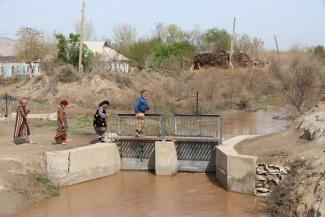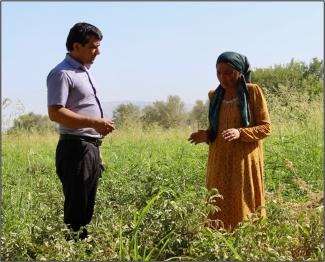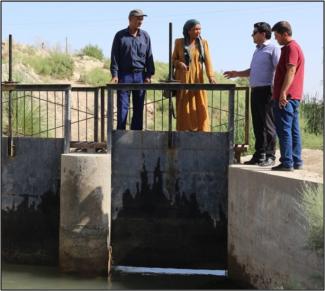Primov Almurot, 52, leads a dehqan village farm in Arabkhona village in Nosiri Khusrav district of Tajikistan’s southern Khatlon region. The farm, which he co-owns with 12 other shareholders, covers seven hectares. On Almurot’s 0.6 hectares of land in the dehqan farm, he plants mostly wheat, corn, and cotton.
The farm’s productivity has drastically declined over the years due to the poor condition of a 7-km-long irrigation canal, which dates back to the Soviet era.
“We who live downstream of the canal feel the negative impact,” says Almurot.
Besides Almurot, three producer groups with 63 members use the water to irrigate their lands. Indirectly, the canal serves 416 village farms covering a total area of 894 hectares, household plots covering more than 212 hectares, 60 hectares of ancillary lands, as well as 1,166 hectares of agricultural land.
According to the Food and Agriculture Organization, Khatlon produces over half of Tajikistan’s agriculture output. However, like farmers around the world, farmers in Khatlon are hamstrung by global warming as well as poor infrastructure.
As demands on the canal grew and the water management declined, harvests dwindled and disputes between farmers during the growing season became common.
“The farmers were about to get physical,” remembers Almurot.
The Thrive Tajikistan: Partnership for Socio-Economic Development is a five-year joint program of the United States Agency for International Development (USAID) and the Aga Khan Foundation (AKF) that aims to enhance integrated socio-economic development in 16 districts of Tajikistan. From October to December 2021, to reduce conflict and improve the quality of people’s lives, the Thrive program stepped in to repair the canal.
Under the Thrive program, six new water regulatory gates were installed, the canal route was partially renovated, and the walls and slopes were reinforced to prevent leakage. This intervention gave real relief to Almurot and hundreds of farm families throughout the district.
“Living in the hottest region, access to sufficient irrigation water was a long-awaited dream. This is why, for our part, we also contributed to the construction process by collecting TJS 15,000 for digging and leveling the main pipeline route. Now, the yield of my corn, for instance, is higher by [almost 680 kg]..My land productivity increased, and I plant tomatoes, potatoes, and many other vegetables due to water availability and sell them in the district market.”
“As a result, I am able to pay the tuition fees for my daughter who is a student at the Tajik State University of Commerce. Most importantly, I don’t have to think about when it’s my turn for irrigation, as there is a responsible person assigned to distribute the water.”
By renovating the canal, AKF was also able to engage female members of the households who are mostly occupied with family care and domestic work. The water shortage had caused Shoira Ostonqulova, 46, a school principal and history teacher, nearly to stop working on her land. Now, she is trying now to allocate more time for her land in the dehqan farm and 0.1 hectares of her private land.
“It would have been difficult to deal with my teaching job and farming at the same time while always thinking about irrigation,” Shoira says. “Now, I have a garden in front of my house and planted apricot, almond, and grape trees, which bring me a reasonable profit.”
This season, she sold apricots and harvested two tons of cotton and 200 kg of almonds. She is eagerly waiting for higher prices in the market. Shoria’s husband also helps her with the farming on the side, while working as a master builder. Their son is in the seventh grade.
Restoring the infrastructure with the gates alone would not have solved the problem. It also required shifting responsibility for the operations and maintenance of the canal to the local water user association (WUA).
One of the WUA members, a person known as a mirob, distributes the water according to a timetable approved by the residents. The association members for the service and for irrigation depend on the type of crop. The money goes to the WUA which ensures the canal’s sustainability and proper water distribution.



